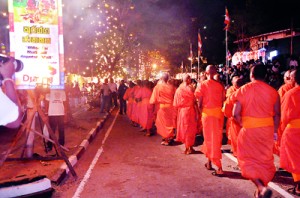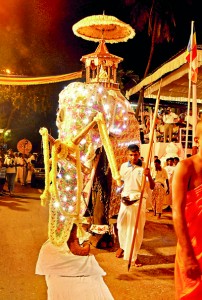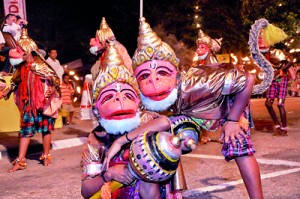Beating to the sounds of culture and religion
The precursor to the modern Navam maha perahera of the Gangarama was a perahera held every July in the early part of the 20th century. It had  elephants- not live ones but wooden models covered in sacking, and running on wheels! This perahera was discontinued after the death of its organiser, the Ven. Devundara Sri Vachissara Thera. It was much later in 1979 that the Gangarama Navam perahera as we know it today began.
elephants- not live ones but wooden models covered in sacking, and running on wheels! This perahera was discontinued after the death of its organiser, the Ven. Devundara Sri Vachissara Thera. It was much later in 1979 that the Gangarama Navam perahera as we know it today began.
This year’s Navam perahera which will parade the streets of Colombo on February 2 and 3 will have over 5000 participants. It will begin at 7 p.m. and go on for about two hours.
Now in its 37th year, having walked Colombo’s streets through periods of civil strife and unrest, the day procession was introduced in the ’80s to accommodate those who were too nervous to watch the perahera at night. This too became a tradition and even today one of the main processions is held during the day.
The perahera has its place in the country’s cultural calendar and many tourists attend to witness a slice of Sri Lankan culture and spirituality. It is

Perahera scenes (file pix)
to the “Podi Hamuduruwo” of the Gangarama, the Ven. Galboda Gnanissara Thera that the credit should go. It was he who, with the then Premier Ranasinghe Premadasa, began the perahera and sustained it with determination even when the elephants in the procession were just five. There were ups and downs- in the mid ‘80s, they hit the record number of 169 and today the perahera boasts of the highest number of elephants in any procession.
Historically, Navam is the poya when the two chief disciples of the Buddha, Seriyuth and Mugalan, were appointed. The perahera is an ‘offering’ to the Triple Gem: the Buddha, the Dhamma or the doctrine, and the Sangha or the revered priests.
A story is often told of the very first perahera in 1979. It is said that the torrential rains which had soaked the spirits of the perahera organisers, ceased at the exact hour when the perahera was scheduled to start. However, as a precaution against any such future impediments the Ven. Gnanissara Thera decided to hold the perahera for two days. That practice has continued.
The Gangarama Navam Perahera is the only procession in which the monks walk in the perahera while chanting pirith. This year there will be around 100 of them. The relics carried with pride are threefold to  represent the Triple Gems. Apart from the Dathu (relics) casket, scriptural texts and a gold statue of Lord Buddha are also paraded to be worshipped by the gathered devotees. Furthermore, no Devale perahera (processions for Hindu gods) is combined with the Navam perahera.
represent the Triple Gems. Apart from the Dathu (relics) casket, scriptural texts and a gold statue of Lord Buddha are also paraded to be worshipped by the gathered devotees. Furthermore, no Devale perahera (processions for Hindu gods) is combined with the Navam perahera.
A very distinctive feature of the Navam perahera, but not a surprising one, as we are talking of what was originally called the ‘Colombo perahera’, has been the occasional participation of Hindu and Muslim dancers alongside the traditionally Sinhalese performers.
Before the main parade, the Gangaramaya temple holds seven Mal peraheras (flower processions) from January 26 as a precursor to the main perahera. At these mini-processions devotees and Sunday schoolchildren carry flowers and walk along the Hunupitiya streets as if to spread the message of the approaching spectacle. On the first day of the main procession, a Seth Pirith is chanted to bless the perahera.
The kasa karayo (whip crackers) who herald the procession beating leather against concrete lead the perahera clearing the path. The sound of the whips is regarded as a Sabda Puja (sound offering). It is believed that the whip cracking is an invitation to heavenly beings to watch the  procession from above.
procession from above.
Representatives of dance troupes from all parts of the island perform traditional and modern dances at the Navam perahera. Many are third generation dancers. These performances can be divided into Udarata Natum (up country dances), Pahatharata Natum (low country dances), Sabaragamu Natum (dances originating from the Sabaragamuwa province) and other dances. The fourth category includes stilt-walkers and groups performing Tamil dances like Kohomba Kale.
It is this aesthetic mix seen in the Navam perahera that makes it a cross section of Sri Lankan culture. The procession is also seen as a platform for local artists to demonstrate their talents and revive the dying arts of Sri Lanka.
“My students and I perform at the Navam Perahera to gain experience and sustain the culture of Sri Lanka,” said R. A Silva, headmaster of the Hikkaduwa Devolmadulage Thelme Dance Academy.
Hewisi drummers flex their muscles and beat on traditional instruments such as the Thammatama (double drum), Dawula (large drum), Thalampota (cymbals) and Horane (trumpet) to create a percussion harmony that moves the dancers. Vannam or metrical verses like the Gajaga (elephant) and Thuranga (horse) which keep beat to imitate the movement of certain animals are performed simultaneously by the drummers and dancers.
Bringing up the rear are the Gini Bola Karayo (fire stuntmen) who skilfully juggle balls of fire to the drum beat.
Youth from the Sri Jinarathana Technical College, which Ven. Gnanissara oversees, are the backbone of the organising process. Additionally, volunteers arrive from all across the island to help. Army personnel also lend a hand. Yet the organizers say the biggest obstacle in staging the Navam Perahera is the lack of volunteer man power who could devote their time and labour.
“I have been helping the temple for 14 years. I am a carpenter by profession and handle putting up platforms along the road. I give my labour out of love and great respect for Buddhism,” said Jayakody Piyanage of Wennappuwa.
“Lord Buddha preached that happiness is the most valuable wealth. The Navam Perahera is an innocent celebration of religion and culture which creates spiritual happiness in the participants as well as the onlookers. The message given by this great event is one of unity, happiness and religious blessing for all of mankind,” Ven. Gnanissara Thera said.


